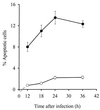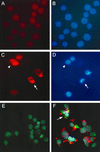Intestinal epithelial cell apoptosis following Cryptosporidium parvum infection
- PMID: 10678994
- PMCID: PMC97335
- DOI: 10.1128/IAI.68.3.1710-1713.2000
Intestinal epithelial cell apoptosis following Cryptosporidium parvum infection
Abstract
Cryptosporidium parvum induces moderate levels of apoptosis of cultured human intestinal epithelial cells, which are maximal at 24 h after infection. Apoptosis is further increased in C. parvum-infected cells by inhibition of NF-kappaB. C. parvum infection also attenuates epithelial apoptosis induced by strongly proapoptotic agents. The data suggest C. parvum has developed strategies to limit apoptosis in order to facilitate its growth and maturation in the early period after epithelial cell infection.
Figures


References
-
- Argenzio R A, Lecce J, Powell D W. Prostanoids inhibit intestinal NaCl absorption in experimental porcine cryptosporidiosis. Gastroenterology. 1993;104:440–447. - PubMed
-
- Argenzio R A, Liacos J A, Levy M L, Meuten D J, Lecce J G, Powell D W. Villous atrophy, crypt hyperplasia, cellular infiltration, and impaired glucose-Na absorption in enteric cryptosporidiosis of pigs. Gastroenterology. 1990;98:1129–1140. - PubMed
-
- Beg A A, Baltimore D. An essential role for NF-κB in preventing TNF-α-induced cell death. Science. 1996;274:782–784. - PubMed
-
- Chen X-M, Gores G J, Paya C V, LaRusso N F. Cryptosporidium parvum induces apoptosis in biliary epithelia by a Fas/Fas ligand-dependent mechanism. Am J Physiol. 1999;277:G599–G608. - PubMed
Publication types
MeSH terms
Substances
Grants and funding
LinkOut - more resources
Full Text Sources

